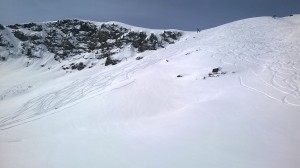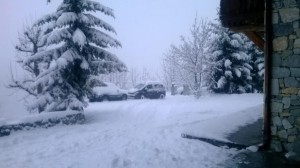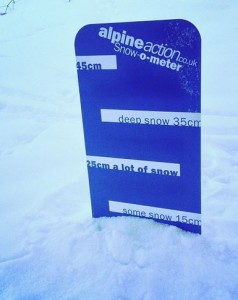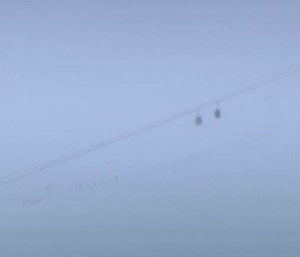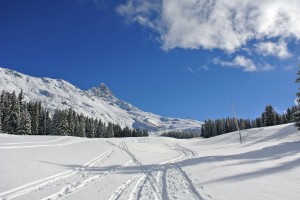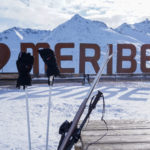3 Valleys Snow Report 8th March 2015  The weather in Meribel has been a mixed bag this week. We started off with snow all the way down to resort which then turned to rain but snow still fell at mid station and above. Tuesday brought us a bluebird day which was followed with more snow on Wednesday, the rest of the week was blue skies and great skiing! The pistes are still in great condition especially in the Courchevel valley. This week we are expecting sunshine all week which should make for good piste skiing. It is starting to warm up a bit here in the 3 Valleys so we expect the best skiing to be in the morning and in to lunch time. The lower slopes might be starting to turn to spring snow in the afternoons so could get a little heavy on the legs on the way back to resort level, La Tania we are looking at you. We still expect for it to be another great week of skiing in the 3 Valleys, just don’t forget to bring your sunglasses and sun tan cream. There are literally only a couple of spaces left in our chalets for the week starting 14/3/2015 so don’t miss out and book today!
The weather in Meribel has been a mixed bag this week. We started off with snow all the way down to resort which then turned to rain but snow still fell at mid station and above. Tuesday brought us a bluebird day which was followed with more snow on Wednesday, the rest of the week was blue skies and great skiing! The pistes are still in great condition especially in the Courchevel valley. This week we are expecting sunshine all week which should make for good piste skiing. It is starting to warm up a bit here in the 3 Valleys so we expect the best skiing to be in the morning and in to lunch time. The lower slopes might be starting to turn to spring snow in the afternoons so could get a little heavy on the legs on the way back to resort level, La Tania we are looking at you. We still expect for it to be another great week of skiing in the 3 Valleys, just don’t forget to bring your sunglasses and sun tan cream. There are literally only a couple of spaces left in our chalets for the week starting 14/3/2015 so don’t miss out and book today! 
Run report – off-piste in Meribel
Run report – off-piste in Meribel
By Alpine Action’s Resort Rep, Rob Bartlett
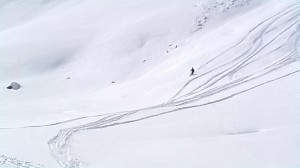 I’ve said before and it is as true now as at the start of the season: one of the best parts of my job is being able to share my own knowledge of the ski resort, passing on tips and suggestions of which pistes to try, where to find the best conditions and how to get the most out of a week skiing in the Three Valleys.
I’ve said before and it is as true now as at the start of the season: one of the best parts of my job is being able to share my own knowledge of the ski resort, passing on tips and suggestions of which pistes to try, where to find the best conditions and how to get the most out of a week skiing in the Three Valleys.
As befits the largest ski area in the world, there are hundreds of kilometres of pistes to enjoy for skiers and boarders of every level. However, for experienced skiers, there is a world of fun to be had beyond the marked and bashed runs.
The rules of off piste
Before saying any more, we need to be totally clear that skiing off-piste can be extremely dangerous. It should only be considered by experienced and confident skiers. As minimum safety precautions you should always look to go in small groups – 3 or 4 is ideal – and never alone. Be aware of the published avalanche risk, but be aware that snow conditions can change rapidly. An hour in the sun can turn safe routes into an unacceptable risk in less than an hour.
Before setting off, you should ensure your insurance covers you for going off-piste and carry and know how to use the relevant safety equipment of a transceiver, shovel and probe. We would strongly recommend engaging an instructor or a guide, and it is always worth checking with the pisteurs for their views on where is safe to go. Always remember that skiing off-piste poses a risk not just to yourself, but also to those who on the mountain around you, such as other skiers on the same slopes, or the secouristes who would conduct a rescue operation if anything went wrong. If you are at all unsure, you should not go.
With the proper precautions however, off- piste skiing can be one of the great highlights of a skiing holiday in the Alps, so where are some of the best routes in Meribel?
Where to find off piste in Meribel
My advice would be to head to the Vallon and Cote Brune sectors. On the Vallon gondola you will most likely see plenty of tracks underneath the lift, which can be accessed from the corner at the top of the Combe de Vallon piste. While this is one of the more recognised and accessible off-piste routes, beware of partially covered rocks.
For those looking to go further into the backcountry, head through the gap in the rock on your left as you come out of the Vallon bubble. There is another reasonably established route straight down hereto the side of the piste, but if you keep left, a small 10 minute walk and a short traverse lead you out to some powder field coming down from the ridge. Check with the pisteurs before attempting this route as the snowpack can be unstable above you, but in the right conditions the fluffy powder, comfortable gradient and spectacular views can make this route a showstopping highlight.
A final route to try is accessed from the top of the Becca lift. In the snowbank opposite the lift you will most likely see tracks leading diagonally up to the ridge line. The top offers a spectacular view both down to Les Menuires one way and across to the Mont Vallon summit the other. Be careful of the entry point here. Traverse across the slope to the centre of the chute to avoid the treacherous rocky drops immediately below where the track up reaches the ridgeline.
The descent down from here looks clear enough but boarders in particular will want to avoid keeping too far left as they will risk being caught out by a flat section right at the bottom before regaining the piste. Equally however, head too far right and you risk being blocked by another few rocky drops, or finding yourself underneath a particularly steep section of the slope where the risk of avalanche is higher. Keep to a conservative line though and you should have a fabulous descent, with the added bonus of being able to admire your track as you head back up the Cote Brune lift.
Snow Report Week Ending 27/12/13
Snow Report Week Ending 27/12/13
Although we have had plenty of sun and blue skies in recent weeks, truth be told by the start of Christmas week we were in need of some snow, particularly on the lower slopes. Fortunately Santa obliged as Wednesday night and Thursday night brought half a metre in resort and even more near the top. The thick blanket enveloped both Meribel and La Tania, meaning that by the time the sun came out on Friday we had the best conditions of the season so far.
Looking to the week ahead, several more light dustings of a few centimeters each are currently predicted, which should help keep the pistes fresh and all the runs open as we see in 2014.
Tis snow report comes from our Resort Rep Rob Bartlett. For a three day snow forecast for Meribel click here.
Snow Report – Three Valleys 20-12-13
Snow Report Week Ending 20/12/13
Guests thus far have enjoyed uninterrupted blue skies as the sun has shone down in Meribel. The thick base laid down in late November has held up very well but some runs were starting to show signs of wear. As if on cue, Thursday saw a gentle but persistent snowfall through late morning and early afternoon. The dusting has just served to freshen up some of the key routes through the resort, particularly the Forêt and Doron runs down to the Chaudanne, while Lapin back to Meribel Village is in as good shape as many can remember.
Looking further ahead, forecasts are predicting heavy snowfall for the early part of next week – an ideal Christmas present for those joining us in resort next week.
Check out our snow forecast for Meribel and La Tania.
This weeks report was provided by our resort Rep, Rob Bartlett
Snow – The Facts
Snow – The Facts
To some snow may just be “the white stuff” that either causes travel delays, is good for snowball fights or good for siding down hills. To the more geeky,;p’[ it is (1) an ice particle formed by sublimation of vapor in the atmosphere (2) a collection of loosely bonded ice crystals deposited from the atmosphere; high density snow (greater than 550 kilograms per cubic meter; 34 pounds per cubic foot) is called firm if it is older than one year.
So we thought it might be helpful to create a quick guide to snow.
How it forms.
The conditions must be right for snow to form. Up in the atmosphere it must be below zero degrees and there has to be a minimum amount of moisture in the air. Of course the ground needs to also be below zero for it to fall and settle. Some people claim that it can be too cold to snow, this in actually an old wife’s tale. A snow flake starts life when the moisture in the air freezes to make an ice crystal, these then stick together to form a snowflake. Once the snowflake is heavy enough it will fall to the ground.
Types of snow
For the purposes of this article we are just going to look at wet snow and dry snow. The snow that we are less interested in is wet snow. Wet snow is good for making snowmen, which would suggest that it is sticky and not great for sliding on. Wet snow occurs when the temperature is slightly warmer than the optimum zero degrees, the temperature melts the edges of the flakes causing them to stick together and create bigger heavy flakes. The good stuff is the dry snow which forms small powdery flakes that don’t stick together.
Working out what type of snowfall it is
The snow is falling and you’re putting off your venture to the lifts, in the end you go out and have fun and get cold, but how many times have you claimed to have skied in a blizzard? The chances are you didn’t. Here are the definitions of types of snow fall for next time. To be defined as a blizzard the snow fall must last three or more hours, be in sub-zero temperatures, have a strong wind and the visibility must be less than a quarter of a mile. A snow storm is when there has been a large amount of snow fallen. And a now flurry is when snow falls in varying degrees of intensity with little or no obvious build up on the ground.
The snowpack
This is the name given to the snow on the ground or snow cover. Once the snow has settled, being either wet or dry, it undergoes another transformation, some snow will become several types of snowpack in its lifetime. To start with it will be called new snow, and if it is dry snow it is actually called powder snow. After a while this snow goes on to become Névé snow which is newish snow that has melted slightly, been frozen again and then compacted, this type of snowpack is what most of us will ski on. Most snow will melt after a season, the snow that doesn’t will probably have settled on a glacier. This is actually how glaciers form, (but that is a different article).
A few other things you might need to know
Do you know what a cornice is? Well you should, as they can present serious danger to the winter sport enthusiast. A cornice is an overhang of snow and ice created by the wind, you will find these on the top of cliffs and mountains. Another thing that you may come across is a crust, which is a hard surface of snow on top of soft snow. It is like a pie and is caused by extreme variations in temperature, often associated with spring snowfall.
Meribel Chalet Holidays
Contact Us
Our Favorite Topics
- #albertaction (3)
- Alpine Action (228)
- Alpine Action @25 (5)
- AtoZ (5)
- Comment (17)
- Covid 19 (1)
- Family Skiing (10)
- First Family Ski Trip (6)
- Funny (27)
- La Tania (138)
- Live Blog (12)
- Meribel (188)
- photo competition (2)
- Quiz (2)
- Ski (96)
- Snow Report (56)
- Snowboard (8)
- Tips (58)
- Uncategorized (40)
- Whats On (39)
- Winter Olympics (4)


